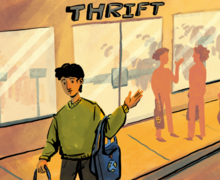Molding a home: Syracuse Ceramic Guild has fostered artists since 1947
Casey Russell | Feature Editor
Since 1947, the Syracuse Ceramic Guild has been a haven for artists and sculptors living and working in the area.
Stephen Waldron has a master’s degree and a Ph.D. in social science, but one of his biggest passions is working with his hands. It was this passion that brought the 72-year-old Syracuse resident to the Syracuse Ceramic Guild in 1974.
Waldron has been at the guild for decades now, but the history of the Syracuse Ceramic Guild itself stretches back to the 1940s. The guild has been a haven for artists and sculptors living and working in the area since 1947.
“The purpose of the guild is to promote information and education about the ceramic arts,” Waldron said. “It is a nurturing environment for potters to get together, have collective workshops and share ideas, and bring in the occasional outside presenter.”
Right now, the guild is laying the framework for the spring and summer months by inviting more artists to share techniques and learn to make new tools. They’re planning a Raku demonstration at the Everson Museum of Art this summer.
There are 75 active members of the guild, ranging from amateurs to full-time potters. The diversity in experience helps test out new techniques, said Waldron, who found his niche in the ceramic arts after spending a couple of years in Asia.
His time in Asia introduced him to a thriving folk art tradition centered around clay. He was fascinated by the process of working on a wheel.
“When I was back in the U.S. and had the opportunity to get my hands on clay, I thought that would be an interesting thing to do,” Waldron said. “So I did.”
He now has his own wheel in his ceramics home studio.
The wheel is only one of the signature tools that the guild members work with — one of their most prized possessions over the years was the large salt fire kiln in the Stone Quarry Hill Art Park in Cazenovia. For the years that it was operational, the fire would be held at 2200 degrees Fahrenheit, and the piece, imbued with salt, would be immersed. The salt and the silicon from the glaze reacted to create the classic look of 19th century commercial jugs and jars: greyish with an orange sheen.
While the kiln in the park has fallen out of use now, the rest of Stone Quarry Hill Art Park remains a major part of the guild’s framework.
One of the founders of the guild, Dorothy Riester, bought land near the stone quarry in the 1950s to build a holiday retreat home now called the Hilltop House. In 1991, she and her husband began converting the property into the park that it is today. In the park, the guild hosts its biggest event of the year: The Pottery Fair, held during the third weekend of every August.
The Pottery Fair is the largest event that takes place at the park as well as the guild’s biggest fundraising event. The guild uses the admission fees to finance upkeep, workshops and demonstrations.
The president of the guild, Marcus Acevado, said about 30 artists participate to organize the fair each year. His job is to make sure the guild pulls it off without a hitch.
A member for about three years now, Acevado takes care of things from the top — organizing and overseeing events, and staying in touch with organizations like the Everson Museum of Art and the Stone Quarry Hill Art Park.
Over the years, he said his appreciation for all that the guild does has grown.
“It’s relatively inexpensive for all the amazing programming we do,” Acevado said about the guild’s activities. “They were looking for new people to join and revitalize it. I joined and helped out with different events, and really enjoyed the camaraderie of my fellow artists.”
That camaraderie comes into play at the fair. Artists collaborating with one another to bring their wares, assemble demonstrations and ensure the audience is entertained. Food is served at the fair and a tent is pitched for children to play in.
The most popular activity at the fair is the process of Raku. With most firing techniques, making a piece can take time that guests at the fair do not have. But with Raku, they watch the raw material being fired, glazed, dried and transformed before their eyes.
Raku, Waldron said, ties back to Japanese tea ceremonies. The fire is kept at a lower temperature to work with clay that takes thermal shock. The method is popular with visitors because they can pick up a piece that the guild makes, glaze it and let it dry all in one afternoon. After that, they can take it home.
Pualani Wiley, another guild member, said Raku is the highlight because it has the most “wow factor.”
“It is amazing to see the white bisque go to finished piece you can take home,” Wiley said. Wiley got her bachelor’s degree in ceramics from Syracuse University five years ago, and has been a resident in a pottery workshop in China. Yet, the journey from raw material to finished products never ceases to fascinate her.
“I find it amazing that you can take a pile of powder or dry dirt, mix it all together and end up with a mug, cup or plate that you can use,” she said. Functionality factors into her work in a major way: If she makes something that has use value, it becomes all the more personal.
Many artists work alone for most of the time. Both Wiley and Waldron have their own studios at home, where they are currently working with wheels or hand building. But the minute any member hits a roadblock, the guild is at hand with answers and help.
Even if they are not meeting officially, guild members still get together for potlucks and bounce ideas off one another, helping each other with problems the group understood best — if a kiln wasn’t burning right or a technique wasn’t getting the desired results.
Be it with each other or learning from outside presenters, sharing their collective knowledge with each other is a habit with the guild members. Outside presentations foster that learning environment.
“It creates a dialogue with these artists,” Acevado said about the effect that visiting artists have. “You see their work, get inspired, use their techniques on your work and make them personal, too. It’s a great community for us to share and learn from each other.”
All three members of the guild agreed that the future for ceramics arts and awareness of pottery in Syracuse looked bright. Waldron mentioned that competitions and workshops at Onondaga Community College, Syracuse University and area high schools keep the ceramic tradition going strong.
“We hope to continue going the way we’re going. Our goal is to educate the community about clay, ceramics, the process, and make people aware of where the pottery in their cupboards comes from,” Wiley said.
Ceramics and pottery comes with persistent work: You get an idea, develop it and then comes a lot of repetition to perfect the technique, Waldron said. This effort is the reason Wiley is earnest about people knowing where the pottery in their cupboards comes from.
Waldron paused and pointed out that industry means more than business in the guild.
Said Waldron: “It is industry in that it’s human effort, but it’s much more personal in craft.”
Published on February 15, 2017 at 11:44 pm
Contact: dmurthy@syr.edu





